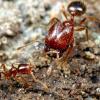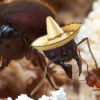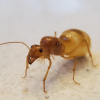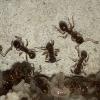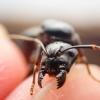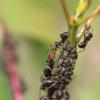This post is meant to serve as a PSA for antkeepers in the southwestern United States concerning the truth about the species Camponotus fragilis and their related species.
This issue was brought to my attention this spring when I was having a casual conversation about the species Camponotus fragilis with a friend of mine. I was mentioning how excited I was to move to Arizona, and in mentioning all the species I could catch, C. fragilis was brought up. He mentioned that he disliked the species, and I was dumbfounded! While visiting AZ the previous summer, I had found a colony of C. fragilis under a rock, with some queen alates. I distinctly remember the queen alates being quite large, almost reaching the size of the temperate Camponotus spp. queens that I was used to. However, to my surprise, the "Camponotus fragilis" that my friend had purchesed in California had an absolutely microscopic queen, being only 9 or 10mm, according to him. This just wasn't right, I was certain that the queen alates I had seen were at least 15mm. I had to look into it for the sake of my own sanity.
I quickly hopped on AntWeb. After a bit of looking around, I found out that the southwest US has several yellow Camponotus spp. Surely not every single queen caught in the southeast was C. fragilis, right?
My research yielded 5 species to look into further; C. absquatulator, C. festinatus, C. fragilis, C. microps, and C. vafer. In this post, I will be largely ignoring Camponotus vafer for reasons I will detail later.
My first goal was to find out the sizes of each species that I was looking at. All except C. absquatulator had a queen specimen imaged, which made my life a bit easier. After reviewing the specimens, I found that I indeed was not crazy, and C. fragilis do in fact have large queens. The species that I was finding in Arizona was indeed C. fragilis. I further confirmed this by keying out some workers under a microscope, which turned out as true C. fragilis.
Now, I needed to solve the issue of the tiny yellow Camponotus queens from California. I had heard from a number of Californians that their "C. fragilis" had absolutely tiny queens, only around 9-10mm. This clearly did not add up, as C. fragilis queens are nowhere near that small. Just take a look:
Now, I needed to figure out what species these Californians were finding. I refused to allow them to continue to be called C. fragilis, as it was giving this species a bad name. I needed to clear their record and confirm that these smaller queens were in fact a different species. Between the remaining 4 species I had, I instantly could rule out C. vafer. They are arboreal, and not present in California. This leaves C. absquatulator, C. festinatus, and C. microps.
A quick look at a C. festinatus queen specimen confirmed my fears:
She's huge too! Surely this is not what is being sold in California at all. It turns out the Camponotus festinatus-complex is pretty diverse, and now all I needed to do was find out what species they're catching over there in CA.
I next looked at C. microps. It was a near perfect match, however there was one issue. They aren't found in California at all. I actually found a queen of this species in Tucson, AZ, and she was only 9-10mm when alive. Here's a queen specimen, just to confirm:
This proves that these yellow Camponotus spp. can indeed get small. All that was left was to find one in California. This only left one option, C. absquatulator. Quickly all of the pieces started falling into place. They are present in California. Their AntWiki page describes them as "Similar to Camponotus festinatus but overall size smaller". Everything was coming together. However one last look at Camponotus fragilis' AntWiki page confirmed all my suspicions;
"In California C. fragilis appears to be uncommon and is replaced in the lower desert of Imperial and Riverside Counties by Camponotus absquatulator"
Bingo.
This all but confirms it. These Californians are almost certainly not catching Camponotus fragilis at all, rather the much smaller Camponotus absquatulator. As far as I'm concerned, this is blissful ignorance. It took me all of 10 or 15 minutes to figure this out, yet these Californian sellers are more than content with selling their 9-10mm Camponotus absquatulator queens as "Camponotus fragilis". This, in my opinion, should be considered dishonestly and false advertising. It baffles me that nobody has figured this out yet. As a species, C. fragilis now has a tarnished reputation. They are known as being small and uninteresting, when promised online to be a large, interesting species. This post will hopefully serve to inform people about what is going on with the sellers from California, and maybe why your beloved Camponotus fragilis queen is so small. Normally I don't like being this harsh, but this seems like a serious problem with a simple solution that has been overlooked for years. I'm also not saying that nobody in California has real Camponotus fragilis, however it seems very common for Camponotus absquatulator to be sold with false advertising.
One thing that may get brought up is that Camponotus absquatulator has far fewer records on Antmaps.org in California than C. fragilis does. However, this is easily explained, since C. absquatulator was only described in 2006, where Camponotus fragilis were described in 1893. They've had just a bit more time to build up records and be more well-documented.
TL;DR: Most "Camponotus fragilis caught in California are actually Camponotus absquatulator, and are commonly being falsely listed by Californian sellers.
Edited by CheetoLord02, August 8 2020 - 6:39 PM.




